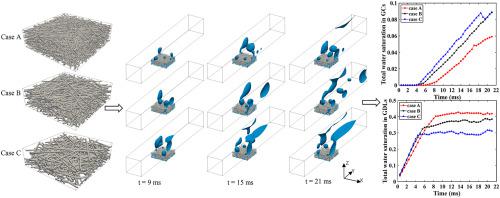当前位置:
X-MOL 学术
›
Int. J. Hydrogen Energy
›
论文详情
Our official English website, www.x-mol.net, welcomes your
feedback! (Note: you will need to create a separate account there.)
Numerical simulation of two-phase flow in gas diffusion layer and gas channel of proton exchange membrane fuel cells
International Journal of Hydrogen Energy ( IF 8.1 ) Pub Date : 2023-01-27 , DOI: 10.1016/j.ijhydene.2023.01.013 Danan Yang , Himani Garg , Martin Andersson
International Journal of Hydrogen Energy ( IF 8.1 ) Pub Date : 2023-01-27 , DOI: 10.1016/j.ijhydene.2023.01.013 Danan Yang , Himani Garg , Martin Andersson

|
Liquid water within the cathode Gas Diffusion Layer (GDL) and Gas Channel (GC) of Proton Exchange Membrane Fuel Cells (PEMFCs) is strongly coupled to gas transport properties, thereby affecting the electrochemical conversion rates. In this study, the GDL and GC regions are utilized as the simulation domain, which differs from previous studies that only focused on any one of them. A Volume of Fluid (VOF) method is adopted to numerically investigate the two-phase flow (gas and liquid) behavior, e.g., water transport pattern evolution, water coverage ratio as well as local and total water saturation. To obtain GDL geometries, an in-house geometry-based method is developed for GDL reconstruction. Furthermore, to study the effect of GDL carbon fiber diameter, the same procedure is used to reconstruct three GDL structures by varying the carbon fiber diameter but keeping the porosity and geometric dimensions constant. The wall wettability is introduced with static contact angles at carbon fiber surfaces and channel walls. The results show that the GDL fiber microstructure has a significant impact on the two-phase flow patterns in the cathode field. Different stages of two-phase flow pattern evolution in both cathode domains are observed. The liquid water in the GDL experiences water invasion, spreading, and rising, followed by the droplet breakthrough in the GDL/GC interface. In the GC, the water droplets randomly experience accumulation, combination, attachment, and detachment. Due to the difference in surface wettability, the water coverage of the GDL/GC interface is smaller than that of the channel side and top walls. It is also found that the water saturation inside the GDL stabilizes after the water breakthrough, while local water saturation at the interface keeps irregular oscillations. Last but not the least, a water saturation balance requirement between the GDL and GC is observed. In terms of varying fiber diameter, a larger fiber diameter would result in less water saturation in the GDL but more water in the GC, in addition to faster water movement throughout the total domain.
中文翻译:

质子交换膜燃料电池气体扩散层和气体通道中两相流的数值模拟
质子交换膜燃料电池 (PEMFC) 的阴极气体扩散层 (GDL) 和气体通道 (GC) 内的液态水与气体传输特性密切相关,从而影响电化学转化率。在本研究中,GDL 和 GC 区域被用作模拟域,这与以前只关注其中任何一个的研究不同。采用流体体积 (VOF) 方法对两相流(气体和液体)行为进行数值研究,例如,水输运模式演变、水覆盖率以及局部和总水饱和度。为了获得 GDL 几何结构,开发了一种基于内部几何结构的 GDL 重建方法。此外,为了研究 GDL 碳纤维直径的影响,使用相同的程序通过改变碳纤维直径但保持孔隙率和几何尺寸恒定来重建三个 GDL 结构。壁润湿性是通过碳纤维表面和通道壁的静态接触角引入的。结果表明,GDL 纤维微观结构对阴极场中的两相流模式有显著影响。在两个阴极域中观察到两相流模式演变的不同阶段。GDL 中的液态水经历水侵入、扩散和上升,然后 GDL/GC 界面中的液滴突破。在 GC 中,水滴会随机经历堆积、组合、附着和分离。由于表面润湿性的差异,GDL/GC 界面的水覆盖率小于通道侧和顶壁的覆盖率。 研究还发现,突破水后 GDL 内部的含水饱和度趋于稳定,而界面处的局部含水饱和度保持不规则振荡。最后但并非最不重要的一点是,观察到 GDL 和 GC 之间的水饱和度平衡要求。就不同的纤维直径而言,较大的纤维直径会导致 GDL 中的水饱和度较低,但 GC 中的水饱和度较高,此外,整个域中的水运动速度也更快。
更新日期:2023-01-27
中文翻译:

质子交换膜燃料电池气体扩散层和气体通道中两相流的数值模拟
质子交换膜燃料电池 (PEMFC) 的阴极气体扩散层 (GDL) 和气体通道 (GC) 内的液态水与气体传输特性密切相关,从而影响电化学转化率。在本研究中,GDL 和 GC 区域被用作模拟域,这与以前只关注其中任何一个的研究不同。采用流体体积 (VOF) 方法对两相流(气体和液体)行为进行数值研究,例如,水输运模式演变、水覆盖率以及局部和总水饱和度。为了获得 GDL 几何结构,开发了一种基于内部几何结构的 GDL 重建方法。此外,为了研究 GDL 碳纤维直径的影响,使用相同的程序通过改变碳纤维直径但保持孔隙率和几何尺寸恒定来重建三个 GDL 结构。壁润湿性是通过碳纤维表面和通道壁的静态接触角引入的。结果表明,GDL 纤维微观结构对阴极场中的两相流模式有显著影响。在两个阴极域中观察到两相流模式演变的不同阶段。GDL 中的液态水经历水侵入、扩散和上升,然后 GDL/GC 界面中的液滴突破。在 GC 中,水滴会随机经历堆积、组合、附着和分离。由于表面润湿性的差异,GDL/GC 界面的水覆盖率小于通道侧和顶壁的覆盖率。 研究还发现,突破水后 GDL 内部的含水饱和度趋于稳定,而界面处的局部含水饱和度保持不规则振荡。最后但并非最不重要的一点是,观察到 GDL 和 GC 之间的水饱和度平衡要求。就不同的纤维直径而言,较大的纤维直径会导致 GDL 中的水饱和度较低,但 GC 中的水饱和度较高,此外,整个域中的水运动速度也更快。

































 京公网安备 11010802027423号
京公网安备 11010802027423号